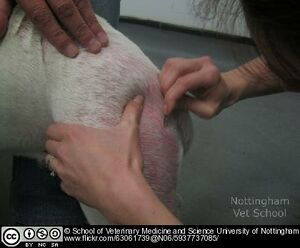Skin Scrape Procedure
Introduction
Skin scrapings are a very common and important technique in the diagnosis of skin disease for all mammals and some reptiles and fish. They are particularly valuable in parasitological investigations.
Equipment
- Scalpel blade
- Microscope
- Oil or Liquid Paraffin
- Surgical spirit or surgical scrub solution
- Microscope slides and cover slips
Preparation
The skin should preferably not be clipped or scrubbed prior to scraping as this will affect the sample quality. Clipping may be necessary in heavily haired areas but it should be avoided if possible. It is preferred to clean the area with surgical spirit or scrub afterwards.
Prepare a microscope slide with a drop of mineral oil or liquid paraffin placed in the centre.
No sedation or anaesthesia is usually required unless the animal's temperament prevents good quality samples being collected. Most animals tolerate the procedure very well.
Procedure
Choose the area that is to be sampled. It is best to scrape the periphery of any obvious lesions as this is where parasites tend to congregate and tissue is healthiest. Several samples should be taken from different regions as parasites can be very difficult to find.
Run the scalpel blade along the desired area repeatedly in the same direction at an angle of ~45 degrees. It may be beneficial to dip the blade in a small amount of oil or liquid paraffin prior to scraping. Continue until the skin shows petechial haemorrhages. Do not continue until bleeding is copious as this will cloud the slide and make interpretation difficult. It is important that deep skin scrapes like this are taken when scraping for suspect Demodex mites or other deep burrowing mites, so that the hair follicle bulbs can be analysed. It may be prudent to scrape this way for any suspect parasitic infection as it will reveal both superficial and deep mites.
Tissue should then be transferred from the scalpel to a clean microscope slide with a small amount of oil/liquid paraffin already placed on the slide and gently spread over the surface of the slide. A cover slip should then be added.
Interpretation
Slides should be examined systematically under a light microscope at 100x magnification. The light output should be reduced for best mite visualisation. Alternatively, they can be sent to a laboratory for analysis.
If parasites are suspected, repeat sampling may be prudent, as may preventative treatment with an ectoparasiticide. If demodicosis is diagnosed and an animal is undergoing treatment, three negative scrape results on three separate occasions are required to confirm a curative result.
Skin Scraping in Fish
When taking skin scrapings from fish, only the mucus is sampled; the epidermis should not be broken. A blunt metal or wooden scraper/spatula should be used and the mucus placed onto a slide with a small amount of tank/pond water (chlorine and other minerals in tap water may kill any parasites present). The slide can be interpreted in the same way as those from mammals. Fish may be sedated for the procedure if required to prevent damage or injury.
| Skin Scrape Procedure Learning Resources | |
|---|---|
 Test your knowledge using flashcard type questions |
Ornamental Fish Q&A 19 |
References
FishDoc (2009) Taking a skin scrape Accessed online at http://www.fishdoc.co.uk/microscope/micro06.htm on 22/11/2011.
Lewbart, G.A (1998) Ornamental Fish Self Assement Colour Review Guide. Manson Publishing. Question 19.
Muller, G. H., Kirk, R. W., Scott, D. W., Griffin, C. W (2001) Small Animal Dermatology. Elsevier Health Sciences.
Rosenfeld, A. J., Dial, S. M (2010) Clinical Pathology for the Veterinary Team. Wiley & Sons.
| This article has been peer reviewed but is awaiting expert review. If you would like to help with this, please see more information about expert reviewing. |
